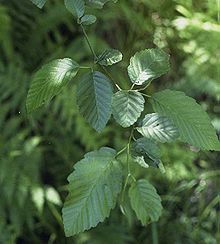Alnus rubra
| Red alder | |
|---|---|
 |
|
| Red alder leaves | |
| Scientific classification | |
| Kingdom: | Plantae |
| (unranked): | Angiosperms |
| (unranked): | Eudicots |
| (unranked): | Rosids |
| Order: | Fagales |
| Family: | Betulaceae |
| Genus: | Alnus |
| Subgenus: | Alnus |
| Species: | A. rubra |
| Binomial name | |
|
Alnus rubra Bong. |
|
 |
|
| Natural range of Alnus rubra | |
| Synonyms | |
|
|
Alnus rubra, the red alder, is a deciduous broadleaf tree native to western North America (Alaska, Yukon, British Columbia, Washington, Oregon, California, Idaho and Montana).
It is the largest species of alder in North America and one of the largest in the world, reaching heights of 20 to 30 m (66 to 98 ft). The official tallest red alder (1979) stands 32 m (105 ft) tall in Clatsop County, Oregon (USA). The name derives from the bright rusty red color that develops in bruised or scraped bark. The bark is mottled, ashy-gray and smooth, often draped with moss. The leaves are ovate, 7 to 15 centimetres (2.8 to 5.9 in) long, with bluntly serrated edges and a distinct point at the end; the leaf margin is revolute, the very edge being curled under, a diagnostic character which distinguishes it from all other alders. The leaves turn yellow in the autumn before falling. The male flowers are dangling reddish catkins 10 to 15 cm (3.9 to 5.9 in) long in early spring, and female flowers are erect catkins which develop into small, woody, superficially cone-like oval dry fruit 2 to 3 cm (0.79 to 1.18 in) long. The seeds develop between the woody bracts of the 'cones' they are shed in the autumn and winter.
Alnus rubra grows from southeast Alaska south to central coastal California, nearly always within about 200 km (120 mi) of the Pacific coast, except for an extension 600 km (370 mi) inland across Washington and Oregon into northernmost Montana.
...
Wikipedia
